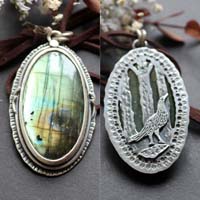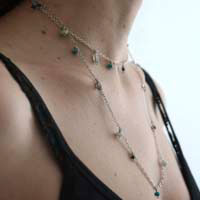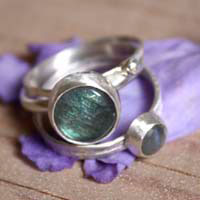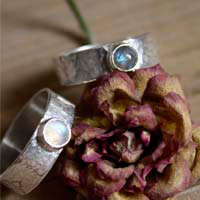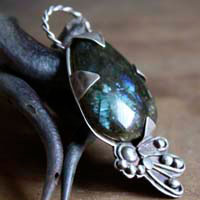- Jewelry
- Inspiration
- Good Deals
- Paintings
- About
- Contact
JEWELRY
- Anklet
- Bracelets
- Brooches
- Cufflinks
- Earrings
- Pendants & Necklaces
- Rings
- Draw your jewelry
- GOOD DEALS
- How to clean your jewel
- Metal we used
INSPIRATION
Labradorite: history, healing properties and lithotherapy

Labradorite properties
The name labradorite originates from Canada, specifically from the Labrador region, where it was discovered around 1770 by Moravian missionaries who were evangelizing the Inuit people.
This mineral is a true gem of nature, renowned for its metallic iridescent reflections that captivate the eye. These reflections, known as labradorescence or Schiller effect, result from light interference within micro-inclusions and paired internal lamellae, which are characteristic of this plagioclase feldspar.

Labradorite offers a fascinating color palette, ranging from blue to violet, sometimes enriched with shades of green, yellow, or orange, depending on its variety. Some specimens display a true fireworks display of colors, showcasing several hues simultaneously. This unique optical phenomenon gives the impression that the stone captures and diffuses light, evoking a "light trap" that changes its appearance depending on the angle of observation.
Labradorite belongs to the feldspar family, with an approximate chemical formula of (Ca,Na)(Al,Si)₄O₈. Its hardness is between 6 and 6.5 on the Mohs scale, making it relatively resistant, although sensitive to scratches. Its density ranges from 2.68 to 2.72 g/cm³.
Another significant deposit was discovered in Finland around 1940, during World War II, as miners were setting traps for enemy tanks. This Finnish labradorite, known as Spectrolite, is distinguished by its particularly vivid color spectrum and is highly sought after in the gemstone market today.
In addition to Labrador and Finland, labradorite is also mined in Ukraine, Madagascar, Australia, Russia, and Mexico. Each region produces specimens with slightly different chromatic characteristics.
Labradorite is sometimes referred to as the "rainbow moonstone" because of its shimmering reflections. It is also known by other names, such as carnite, hafnefjordite, mauilite, radauite, silicite, or spectrolite.
Notable varieties of labradorite include:
- Golden labradorite, which primarily displays yellow and golden reflections.
- Black labradorite, also called Larkivite, with dark and metallic reflections.
- Spectrolite, famous for its brilliant colors and exceptional color spectrum.
Labradorite is also used in architecture and decoration due to its striking visual appearance. Some facades of prestigious buildings are adorned with this mineral, whose reflections attract and captivate the eye. Of lower quality, it can also be found in the form of light yellow transparent crystals. Though fragile and lacking the characteristic labradorescence, this variety may still hold some aesthetic value. One of the most notable examples is the Lenin Mausoleum in Moscow, designed by architect Alexei Shchusev. Built between 1924 and 1930, this monument combines red granite and black labradorite. The red granite symbolizes communism, while the black labradorite was chosen to evoke mourning. This material, appreciated for its iridescent reflections, contributes to the monument’s somber and monumental appearance, located near the Kremlin. Another prominent example of labradorite use in famous buildings is the Palais des Congrès in Montreal, a modern architectural landmark. Designed by architect Moshe Safdie, this building uses labradorite for its exterior facades. The labradorite panels reflect and capture light, creating a fascinating visual effect and adding an elegant and modern touch to the building, while reinforcing its monumental aspect.
Stories, legends and beliefs about labradorite

Labradorite, often referred to as the "stone of the Northern Lights," is surrounded by mystery and legends, particularly among Indigenous peoples of Canada, such as the Inuit and the Innus (Montagnais-Naskapis). According to an ancient belief, this stone emerged from the fire of the aurora borealis, then froze in the extreme cold of the northern lands, falling to Earth as a gift from the gods. This myth makes labradorite a sacred stone, directly connected to cosmic forces, representing the crystallized light of the sky embedded in the stone.
Another fascinating legend tells of an Inuit warrior, who, during battle, struck a labradorite with his spear, causing the aurora borealis to appear in the sky. According to this legend, the labradorite fragments found today are the captured shards of light, preserved forever in the stone, maintaining the beauty and power of the northern lights.
For these peoples, labradorite was not just a precious gem but a spirit guardian. They believed it contained the spirits of their ancestors, carrying their wisdom and strength. Seen as a powerful talisman, labradorite was used for spiritual and medicinal purposes, as it was believed to offer protection, healing, and mental clarity. Some reports even suggest that the Inuit used labradorite powder as a remedy for physical and spiritual ailments, perpetuating a tradition of respect and reverence for this divine gemstone.
Labradorite is also associated with more contemporary beliefs, where it is considered a stone that can enhance psychic abilities, increase intuition, and bring emotional and spiritual balance. These mystical attributes of labradorite have transcended time, continuing to influence its use in various spiritual practices today.
Mines: Canada, the USA, France, Madagascar, Russia, Ukraine, Norway and Finland.
Healing properties and benefits of labradorite
Labradorite is a gemstone with a wide range of benefits, frequently used in lithotherapy for its positive effects on both physical and emotional well-being. Here’s a deeper look at its properties:
- Labradorite is often recommended for its impact on hormonal balance, particularly in supporting the endocrine glands. It may help regulate metabolism, especially in cases of thyroid disorders or menstrual issues.
- By stimulating activity in both hemispheres of the brain, labradorite is seen as a stone that promotes mental clarity, improves concentration, and stimulates creativity. It is a valuable ally for artists, writers, or anyone seeking inspiration.
- Physically, labradorite is commonly used to relieve digestive disorders.
- It is also known for its ability to soothe minor eye conditions, such as visual fatigue or irritation, thanks to its calming and regenerative properties.
- The stone is associated with blood circulation, particularly for its role in the absorption of calcium and iron. This action may support cardiovascular health and strengthen the circulatory system.
- Labradorite is recognized for its anti-inflammatory effects. It is thought to be beneficial for those suffering from joint pain, such as arthritis, as well as for muscle pain and other inflammatory symptoms.
- In lithotherapy, labradorite is frequently used to support the respiratory system by helping to soothe respiratory ailments like bronchitis, asthma, or seasonal colds. It may also encourage deep breathing and open the chest.
- The stone is often recommended for its beneficial action during menstruation, easing menstrual cramps and providing support to women during this time.
- Beyond its physical virtues, labradorite is considered a stone of purification. It is renowned for its ability to remove negative energies and restore emotional balance. By aligning the chakras, it also promotes spiritual harmony, aiding in self-awareness and enhancing intuitive abilities.
- Labradorite is also seen as a catalyst for intuition and spiritual awakening. It is believed to facilitate easier connection to higher dimensions, open the third eye, and refine the perception of subtle energies.
- Its "protective" properties are also well-known: it is often worn to ward off negative influences and protect the wearer from external energetic attacks.
 Please note that all healing properties presented for gemstones are gathered from various sources. This information is provided as a service and is not intended to treat medical conditions. It is recommended to consult a healthcare professional for serious medical issues and not to rely solely on gemstones as a treatment.
Please note that all healing properties presented for gemstones are gathered from various sources. This information is provided as a service and is not intended to treat medical conditions. It is recommended to consult a healthcare professional for serious medical issues and not to rely solely on gemstones as a treatment.
Labradorite jewelry samples
To learn more about litotherapy, we recommend you the following books:

